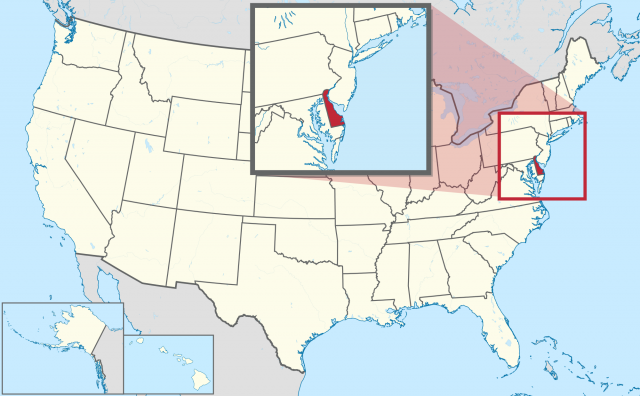The State of Delaware
AT A GLANCE
Name: The name Delaware comes from the Delaware River and Bay, which were named for Sir Thomas West, Baron De La Warr, the first governor of Virginia.
Nicknames: First State, Diamond State
Capital: Dover
Size: 2,396 sq. mi.
Population: 935 614 (2014)
Statehood: Delaware became the first state on December 7, 1787.
Electoral votes: 3 (2016)
U.S. Representatives: 1 (until 2016)
State tree: American holly
State flower: peach blossom
State insect: ladybug
Highest point: Ebright Azimuth, 448 ft.

THE PLACE
Delaware is the second-smallest state and is located in the Mid-Atlantic region of the country. Delaware's coastline is 28 miles long. The state is situated close to many of the nation's largest cities, including Baltimore, Philadelphia, and New York, and the nation's capital, Washington, D.C. Delaware shares the DelMarVa Peninsula with Maryland and Virginia.
Most of the state is low, flat, coastal terrain. The northern area of the state, part of the Piedmont region, is covered with rolling hills and valleys. Much of Delaware is excellent agricultural land.
A 30,000-acre swamp runs along Delaware's southern boundary. The Delaware River is the state's largest river. Lakes and streams are important to Delaware's transportation and economy. Stone, sand, gravel, and clay are the state's most important mineral resources. About a third of Delaware is thickly forested. Delaware's climate is generally humid with hot summers and mild winters, although temperatures along the coastline are more stable and temperate.
Facts and Firsts
- Delaware is known as the First State because it was the first to ratify (approve) the U.S. Constitution, on December 7, 1787.
- Nylon was invented in the Du Pont factories in Seaford.
- The first beauty pageant in the United States, which later became the Miss America Pageant, was held at Rehoboth Beach in 1880. Inventor Thomas A. Edison was one of the three judges.
- Swedish and Finnish settlers built the country's first log cabins along the Delaware River.
- Delaware was an important stop along the Underground Railroad. Delaware resident Thomas Garrett reportedly helped more than 2,000 fugitive slaves escape to safety.
- The Thousand Acre Marsh is northern Delaware's largest freshwater tidal wetland. Analysis of a fossilized pollen sequence from the mucky bottomland determined the swamp's age at 10,000 to 12,000 years old.
- Barratt's Chapel was built in 1780 and was one of Delaware's first churches. The chapel is known as the Cradle of Methodism and is the oldest Methodist house of worship still standing in the United States.
THE PAST
Many different peoples have occupied Delaware throughout its history. For centuries, the area was the home to several Algonquian tribes, including the Delaware and Nanticoke. Europeans first reached Delaware in 1631 when the Dutch settled near the city of Lewes. During the next 50 years, Delaware fell under Swedish, Dutch, and then English control.
In 1664, England took control of the area, then gave it to William Penn, the founder of the colony of Pennsylvania, in 1682.
Although Delaware was known as Pennsylvania's Three Lower Counties, it was relatively independent from the main colony, and fought as a separate state in the American Revolution.
In 1802, Delaware's industrial future was sealed when E.I. Du Pont opened the first Du Pont factory, a gunpowder mill at Wilmington. In 1935, Wallace Carothers of the DuPont Company invented nylon. Since then, Delaware has become increasingly industrialized and many companies and industries locate in the state because it has low taxes.
THE PRESENT
Delaware is home to more than 200,000 different businesses because it is so corporation friendly. Many chemical-producing corporations are located in Delaware. The Du Pont Company is the largest of these and employs the most people.
Other Delaware companies manufacture vulcanized fiber, textiles, paper, medical supplies, metal products, machinery, machine tools, and automobiles. In the city of Wilmington, banking is an important industry.
Delaware's good soil makes it competitive agriculturally. Chicken raising is Delaware's principal type of animal farming. Fishing and dairy farming are also common.
Delaware farms produce a variety of crops, including corn, soybeans, potatoes, and hay.
Each year, thousands of people visit Delaware's historic homes, some of which were built before the American Revolution.The Delaware coastline is also a popular vacation spot. Water-sport and fishing enthusiasts enjoy the state's many scenic lakes and rivers.
Born in Delaware
- Robert Montgomery Bird, playwright
- Henry S. Canby, editor and author
- Annie Jump Cannon, astronomer
- Oliver Evans, inventor
- Henry Heimlich, surgeon and inventor
- Pierre S. Du Pont, chemist and industrialist
- Howard Pyle, artist and author
- Caesar Rodney, patriot, signer of Declaration of Independence
- Elizabeth Shue, actress